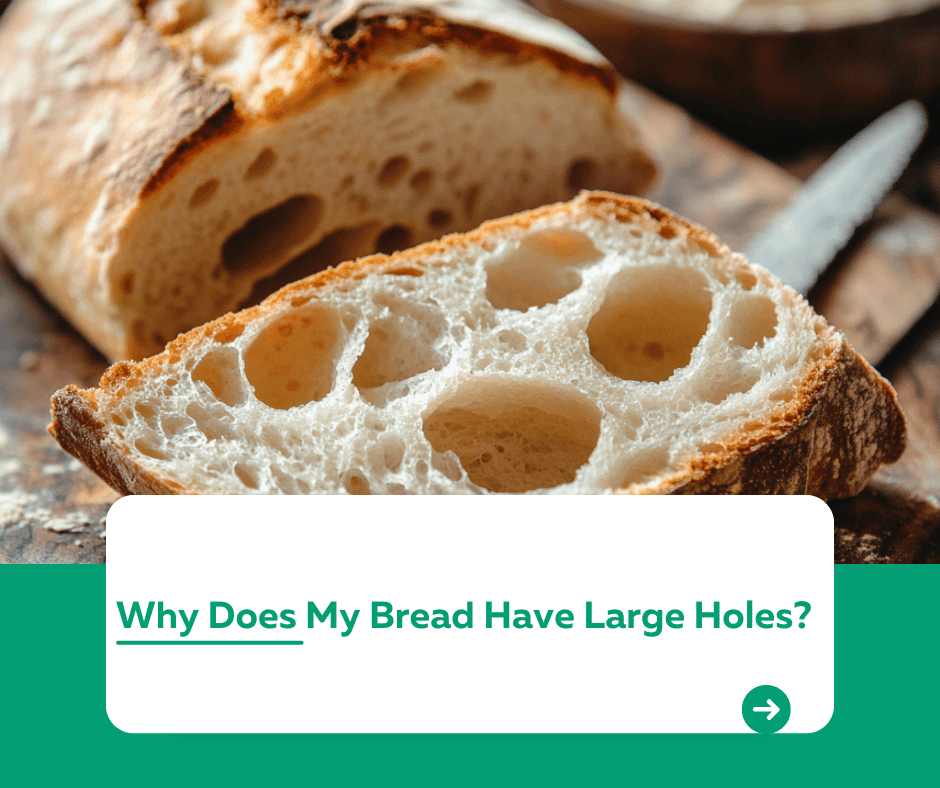
Introduction
“Why does my bread have large holes?”
Large holes in bread can be a delight in some cases, such as artisan sourdough or ciabatta, but they can also be an issue in sandwich loaves or other bread where a uniform crumb is desired. The formation of these holes is influenced by the dough’s fermentation, hydration, kneading, and proofing processes. This guide explains the causes behind large bread holes and how to prevent or encourage them, depending on your bread-baking goals.
1. High Hydration Levels
Bread dough with a high water-to-flour ratio tends to produce larger air pockets.
- Why It Happens: High hydration makes the dough more fluid, allowing gases from fermentation to create bigger holes.
- Best For: Artisan bread like ciabatta or focaccia.
Tip: If large holes are undesirable, reduce the dough’s hydration slightly and ensure thorough mixing.
2. Improper Kneading
Kneading helps distribute yeast and create an even crumb.
- Under-Kneading: Results in uneven gluten development, leading to irregular holes.
- Over-Kneading: Can make the dough too tight, affecting its structure.
Solution: Knead the dough until smooth and elastic, and use the windowpane test to check gluten development.
3. Inconsistent Shaping Techniques
How you shape the dough impacts the distribution of air pockets.
- Why It Happens: Poor shaping traps large air bubbles, which expand during baking.
- Solution: Gently shape the dough to release large pockets of trapped gas while preserving an even crumb.
4. Over-Proofing
Over-proofed dough can cause large holes or uneven crumb.
- Why It Happens: Over-proofing allows too much gas to build up, creating large bubbles.
- Solution:
- Monitor the dough closely during proofing.
- Use the poke test to check readiness—if the indentation springs back slowly, it’s ready to bake.
5. Yeast Activity
Excessive yeast activity can lead to rapid gas formation.
- Why It Happens: Too much yeast or overly warm proofing conditions can cause uncontrolled gas production.
- Solution: Use the correct amount of yeast and proof the dough at an appropriate temperature (75°F–85°F or 24°C–29°C).
6. Baking Temperature
The oven temperature affects how the dough expands during baking.
- Why It Happens: Low oven temperatures can cause uneven oven spring, resulting in large holes.
- Solution: Preheat your oven to the recommended temperature and use a baking stone or steel for even heat distribution.
7. Intentional Techniques for Large Holes
If large holes are your goal, focus on these techniques:
- Use a high-hydration dough.
- Handle the dough gently during shaping to avoid degassing.
- Bake at a high temperature for maximum oven spring.
Conclusion
Large holes in bread can be a feature or a flaw, depending on the type of bread you’re baking. By understanding the factors that contribute to hole formation, you can adjust your technique to achieve the perfect crumb texture for any recipe. Whether you want airy artisan bread or a uniform sandwich loaf, mastering these techniques will help you bake with confidence.
For more baking tips and solutions, visit our Kuestion.com.